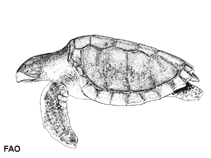Lepidochelys kempii (Garman, 1880)
Kemp's ridley turtle| Native range | All suitable habitat | Point map | Year 2050 |

|
| This map was computer-generated and has not yet been reviewed. |
| Lepidochelys kempii AquaMaps Data sources: GBIF OBIS |
Classification / Names Common names | Synonyms | CoL | ITIS | WoRMS
Not assigned | Testudines | Cheloniidae
Environment: milieu / climate zone / depth range / distribution range Ecology
Demersal. Tropical; 60°N - 9°N, 98°W - 17°E (Ref. 1397)
Distribution Countries | FAO areas | Ecosystems | Occurrences | Introductions
Atlantic Ocean and the Mediterranean (Malta).
Length at first maturity / Size / Weight / Age
Maturity: Lm 60.0 range ? - ? cm Max length : 74.8 cm CL male/unsexed; (Ref. 74991); 65.7 cm CL (female); common length : 65.6 cm CL male/unsexed; (Ref. 1397); max. published weight: 0.00 g
Short description Morphology
Life cycle and mating behavior Maturity | Reproduction | Spawning | Eggs | Fecundity | Larvae
Main reference
References | Coordinator | Collaborators
Hirth, H.F. 1993 Chapter 10. Marine turtles. pp. 329-370. In A. Wright and L. Hill (eds) Nearshore marine resources of the South Pacific. Forum Fisheries Agency (Honiara), Institute of Pacific Studies (Suva) and International Centre for Ocean Development (Canada), 710 p. (Ref. 97534)
IUCN Red List Status
(Ref. 130435: Version 2025-1)
CITES status (Ref. 108899)
CMS (Ref. 116361)
Threat to humans
Human uses
Fisheries: commercial
| FishSource | Sea Around Us
Tools
More information
Max. ages / sizes
Length-weight rel.
Length-length rel.
Length-frequencies
Mass conversion
Abundance
Internet sources
BHL | BOLD Systems | CISTI | DiscoverLife | FAO(Publication : search) | Fishipedia | GenBank (genome, nucleotide) | GloBI | Gomexsi | Google Books | Google Scholar | Google | PubMed | Tree of Life | Wikipedia (Go, Search) | Zoological Record



